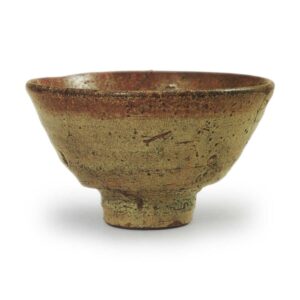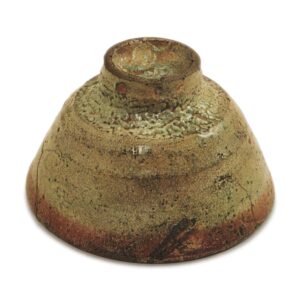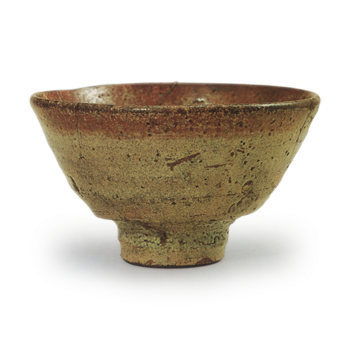

Height: 8.7 to 9.0 cm
Diameter: 14.1 to 14.6 cm
Outer diameter of foot ring: 5.3 cm
Height of rim: 2.2 cm
The name “Amagumo” (rain cloud) is thought to be based on the dark brown tea stains that are attached in a striped pattern to the upper rim of the bowl, near the rim. However, the tea bowl itself does not give the impression of gloominess that might be expected from such a name.
Above all, the clear, unbroken shape and the somewhat feminine but forceful spirit that is imbued in the interior of the bowl strike a chord in the viewer. Generally, the appearance of a large, deep bowl is such that it seems to overflow with its massiveness, but here the contours of the bowl are clearly and neatly delineated, and the tension and fullness of its content, which is rather contained within, is beautiful.
One of the reasons for this is probably that the potter’s wheel was spinning quickly, and the whole piece was appropriately stable.
The gentle glaze tone of the whole piece also characterizes the personality of this tea bowl.
As usual, the part with the foot ring is unglazed, and the rough clay texture can be seen clearly. It looks a little thin, but it is also light in the hand.
As is well known, the key to the appearance of an Ido tea bowl is the style of the foot ring. The foot ring of this Amagumo tea bowl is tall and clearly shaped like a bamboo joint, and its well-formed, dignified shape forms the center of the entire support. The base of the bowl sits firmly on top of this support and is stable, and the opening of the rim is also precise. Everything is tightly packed together, and the well-balanced proportions are the distinctive features of the shape of this bowl.
The glaze is relatively thin and homogeneous on both the inside and outside, and there are fine cracks all over. Perhaps because it was fired a little too lightly, the whole piece has a soft feel to it. In the pale grayish blue of the interior, there are two or three spots of a light yellowish-white color that stand out clearly.
The kaaragi pattern appears with a beautiful bluish hue on the inside and outside of the foot ring, and the strongly carved areas on the side of the foot ring are naturally covered with a thick glaze, making the kaaragi pattern look large and magnificent.
In addition, there are three finger marks from when the glaze was applied, which are lined up close to the edge of the bowl, as well as relatively many small areas where the glaze has flaked off, stuck together in fusuma-gata (sliding door-style) patterns, and worn, and there is a roughly half-circular repair on one part of the rim.
On the black-lacquered lid of the box, there are gold letters that read “Amagumo-ido Chaban”, but the author does not know what this means.
This tea bowl was passed down in the Fukui family of Komatsubara in Kyoto, along with the Ken-ido and Shōan-ido, but it has now been passed to another family. It is a famous bowl that is not well known to the general public.



